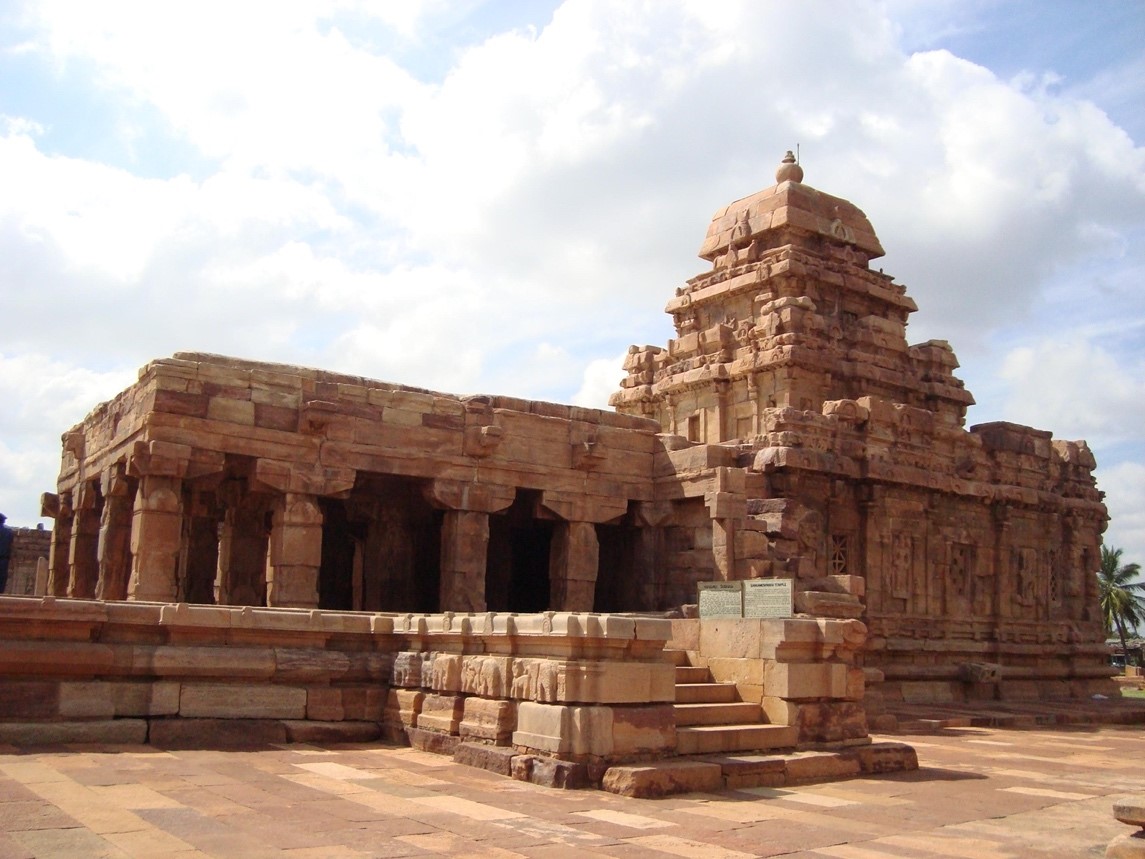
Disclaimer: Copyright infringement not intended.
Context
The recent discovery of two Badami Chalukya temples and a label inscription in Mudimanikyam village, Nalgonda district, sheds new light on the historical and architectural heritage of Telangana.
Details
- The Chalukya dynasty was a prominent Hindu dynasty that exerted its influence over large parts of southern and central India from the 6th to the 12th centuries.
- Throughout its history, the Chalukyas manifested as three distinct yet interconnected dynasties: the Badami Chalukyas, the Eastern Chalukyas, and the Western Chalukyas.
Recent Findings
Badami Chalukya Temples:
- Date: Between 543 AD and 750 AD.
- Architectural Style: Kadamba Nagara style in the Rekha Nagara format.
- Significance: Exceptional examples of Badami Chalukya architecture, unique in Telangana.
- Preservation: With minimal restoration and conservation, these temples can serve as valuable testimonies to the Badami Chalukya period in Telangana.
- Comparison: Apart from the temples at Alampur, these temples represent rare surviving structures from the Badami Chalukya era in the region.
Label Inscription:
- Date: 8th or 9th century AD.
- Inscription: Reads as ‘Gandaloranru’ and is inscribed on a pillar of a group of five temples in the village.
- Interpretation: The meaning of ‘Gandaloranru’ is not entirely clear, but it could possibly be a heroic title, considering that ‘Ganda’ in Kannada means ‘hero.’
- Association: The five temples, known as Panchakuta, can be attributed to the late Badami Chalukya period based on the age of the label inscription.
- Condition: Unfortunately, these temples are not currently in use, with one temple missing the Shivalinga and another containing a Vishnu idol.
Cultural Significance:
- Heritage: These discoveries highlight the rich historical and architectural heritage of the Krishna river valley.
- Preservation Efforts: Scholars and archaeologists emphasize the importance of preserving and conserving these structures to maintain their historical significance.
Origins
- The early origins of the Chalukyas are subject to debate among historians, with various theories proposed.
- However, there's a consensus that the founders of the empire in Badami were native to the Karnataka region of modern India.
- Some theories suggest descent from regional chieftains, while others link them to the Kadamba dynasty, their early overlords.
- The Chalukyas' migration into Karnataka and their subsequent identification as Kannadigas suggest that their place of origin may not have been significant to their identity.
- Inscriptions and historical texts indicate that the Chalukyas were closely associated with the Kannada language and culture.
Historical Significance
The Chalukya rule marked a crucial period in South Indian history, characterized by the transition from smaller kingdoms to large empires. Key aspects of their rule include:
- Consolidation of Power: The Badami Chalukyas established dominance over the region between the Kaveri and Narmada rivers, ushering in a new era of political stability.
- Administrative Innovations: They introduced efficient administrative systems that facilitated governance and contributed to the empire's prosperity.
- Trade and Commerce: Overseas trade flourished under Chalukya rule, bolstering economic growth and cultural exchange.
- Patronage of Arts and Literature: The Chalukyas supported the development of literature in Kannada and Telugu, fostering a vibrant cultural milieu.
Periods in Chalukya History
- Badami Chalukyas: Established by Pulakeshin I in 543 CE, they ruled over a vast territory encompassing present-day Karnataka and parts of Andhra Pradesh.
- Eastern Chalukyas: Originating from the eastern Deccan, they emerged as an independent kingdom after the decline of the Badami Chalukyas. Despite intermittent conflicts, they made significant contributions to Telugu literature and culture.
- Western Chalukyas: Revived in the late 10th century, they ruled over the western Deccan and engaged in frequent conflicts with neighboring powers like the Cholas. Known for their architectural patronage and military prowess, they played a crucial role in shaping regional politics.

Architectural Contributions
The Chalukyas left an indelible mark on Indian architecture, particularly through their distinctive temple constructions.
- Badami Chalukya Architecture: Notable for rock-cut cave temples and structural temples, blending indigenous styles with influences from northern and southern India.
- Western Chalukya Architecture: Characterized by the Karnata Dravida style, exemplified in monuments like the Mahadeva Temple at Itagi and the Kasivisvesvara Temple at Lakkundi.
- Eastern Chalukya Architecture: Known for their temples at Alampur, showcasing unique features influenced by regional aesthetics.
Temple Architecture
- Vesara Style: Blend of Nagar and Dravida styles, prominent in Aihole, Badami, and Pattadakal.
- Cave Temples: Monolithic structures found in Ajanta, Ellora, and Nasik.
- Notable sites: Pattadakal (Raktapura) Group of Monuments, Badami Temples, Virupaksha Temple.
Pattadakal Group of Monuments
- Ten temples built in the 7th and 8th centuries, dedicated to Shiva primarily.
- Features a fusion of north (Rekha-Nagara-Prasada) and south (Dravida-Vimana) Indian architectural styles.
- UNESCO World Heritage site, recognized for its architectural significance.
- Notable temples: Papanatha Temple, Virupaksha Temple.
Badami Temples
- Hindu and Jain cave temples in Badami.
- Cave 1: Features Tandava-dancing Shiva as Nataraja.
- Bhutanatha group: Influenced by both Jains and Lingayats.
- Mallikarjuna Temple: Exhibits Western Chalukya Architecture, with a tiered pyramid structure.
Virupaksha Temple
- Largest temple in Pattadakal, built-in 740 AD.
- Southern-style architecture with high pyramidal tower (shikhara).
- Features sculptures depicting themes from the Ramayana and deities from Shaivism, Vaishnavism, and Shaktism.
Aihole Group of Temples
- Flourished from Pulakesin I to Pulakesin II's reign.
- Exhibits various architectural styles, including Sandhara, Nirandhara, Rekha-Prasada, and Dravidian Vimana.
- Known as the "cradle of Indian temple architecture."
Lad Khan Temple (Aihole)
- Also known as Chalukya Shiva Temple.
- Constructed in Panchayatana style, featuring a rectangular to square structure.
Chalukyas of Badami: Rulers and Their Contributions
- Pulakesin I (540-566 AD)
- Established the city of Vatapi (Badami).
- First sovereign ruler of the Chalukya dynasty.
- Known titles: Vallabheshwar, Satyashraya, Rana-vikrama, Rajasimha, among others.
- Religious practices: Conducted Ashvamedha sacrifices, indicating adherence to Vedic religion.
- Notable inscriptions: Badami rock inscription and Amminabhavi stone tablet inscription.
- Kirtivarman I (566-597 AD)
- Conquests:
- Aihole Inscription records his victories over the Nalas, Mauryas of Konkan, and the Kadambas.
- Conquered Konkan, including the port of Goa (Revatidvipa).
- Notable inscription: Godachi copper plate inscription.
- Pulakesin II (608-642 AD)
- Rise to prominence:
- Kingdom flourished under his reign.
- Titles: Satyashraya, Bhattaraka, Parameshvara, Maharajadhiraja.
- Military achievements:
- Defeated Pallavas in the Battle of Pullalur (AD 618-19).
- Acquired the title "Dakshinapatheshvara" after defeating Harshavardhana (AD 630).
- Engaged in diplomatic relations with the Sassanian Empire.
- Contributions to art and architecture:
- Patronized both Shaivite and Jain temples.
- Notable constructions include the Upper and Lower Shivalayas and the Meguti Jain temple at Aihole.
- Defeat:
- Defeated and killed by Pallava king Narasimhavarman I in the Battle of Vatapi (AD 642).
- Vikramaditya I (644-681 AD)
- Restored order after Pulakesin II's demise.
- Made Pallavas retreat from Vatapi.
Chalukyan Literature
- Languages: Sanskrit, Kannada, Prakrit.
- Notable works: Aihole Inscriptions, Badami Inscription, Saptavataram, Tripadi, Kaumudi Mahotsav.
Administration under Chalukyas of Badami
- Paternalistic control with active involvement of the king in administration.
- Council of ministers advised the king.
- Division into districts called "Vishya" overseen by Vishayadhapati.
- Limited state income from land and declining trade and commerce.
Society and Religion under Chalukyas of Badami
- Revival of Hindu culture and spirituality.
- Support for Vaishnavism, Shaivism, Shakta cults, and Jainism.
- Respect for women in society.

Economy under Chalukyas of Badami
- Limited state income from land.
- Decline in trade and commerce led to reliance on plundering neighboring territories.
Decline of Chalukyas of Badami
- Internal feuds and conflicts with Pallavas weakened the dynasty.
- Continuous wars with Rashtrakutas hastened their decline, leading to their eventual replacement by Rashtrakuta rule in Badami around 750 CE.
Conclusion
The Chalukya dynasty's legacy endures as a testament to the rich cultural and architectural heritage of India. From their origins in Karnataka to their far-reaching influence across southern India, the Chalukyas played a pivotal role in shaping the political and cultural landscape of the subcontinent.
|
PRACTICE QUESTION
Q. From their origins in Karnataka to their far-reaching influence across southern India, the Chalukyas played a pivotal role in shaping the political and cultural landscape of the subcontinent. Discuss. (250 words)
|




